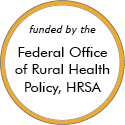Rural Project Examples: Appalachia
Effective Examples
Kentucky Homeplace
Updated/reviewed October 2025
- Need: Rural Appalachian Kentucky residents have deficits in health resources and health status, including high levels of cancer, heart disease, hypertension, asthma, and diabetes.
- Intervention: Kentucky Homeplace was created as a community health worker initiative to provide health coaching, increased access to health screenings, and other services.
- Results: From July 2001 to June 2025, over 202,000 rural residents were served. Preventive health strategies, screenings, educational services, and referrals are all offered at no charge to clients.
Spit It Out-West Virginia
Updated/reviewed March 2025
- Need: Due to West Virginia's high ranking for its use of smokeless tobacco, prevention and cessation education efforts were needed.
- Intervention: Development and implementation of the Spit It Out-West Virginia program.
- Results: Supported by a 2008-2010 grant allowing the program to be delivered to hundreds of people, 5 workplaces became tobacco free. The program continues to be delivered across the state and reaches hundreds with its face-to-face presentations and thousands with its specific media prevention and cessation messages.
Community Health Worker-based Chronic Care Management Program
Updated/reviewed August 2024
- Need: Improve healthcare access and decrease chronic disease disparities in rural Appalachia.
- Intervention: A unique community health worker-based chronic care management program, created with philanthropy support.
- Results: After a decade of use in attending to population health needs, health outcomes, healthcare costs, in 2024, the medical condition-agnostic model has a 4-year track record of financial sustainability with recent scaling to include 31 rural counties in a 3-state area of Appalachia and recent implementation in urban areas.
Project Lazarus
Updated/reviewed May 2024
- Need: To reduce overdose-related deaths among prescription opioid users in rural Wilkes County, North Carolina.
- Intervention: Education and tools are provided for prescribers, patients and community members to lessen drug supply and demand, and to reduce harm in prescription opioid use.
- Results: Opioid overdose death rates have decreased in Wilkes County.
Community-Based Pulmonary Rehabilitation Program
Updated/reviewed January 2024
- Need: More evidenced-based chronic lower respiratory disease management options for rural Appalachia patients, where lung disease rates are among the highest in the country.
- Intervention: Implementation of outpatient pulmonary rehabilitation programs in 2 Federally Qualified Health Centers and a Critical Access Hospital in West Virginia.
- Results: Improved health outcomes for patients with chronic lower respiratory disease, including those with chronic obstructive pulmonary disease.
Trinity Hospital Twin City's Fit for Life

Updated/reviewed November 2018
- Need: To reduce obesity among adults in rural east central Ohio.
- Intervention: Fit for Life Replication Project for Expansion was developed to make it possible to lose weight through practicing healthier lifestyle behaviors.
- Results: Out of the 443 adults who have completed the program, 81% experienced weight loss, a tangible result of the program's overarching goal to enhance levels of health and fitness.
Promising Examples
Successfully Training and Educating Pre-medical Students (STEPS)
Updated/reviewed March 2025
- Need: To increase the number of primary care providers in northeast Kentucky.
- Intervention: STEPS provides support such as physician shadowing, mock interviews, and MCAT practice courses/exams for regional students applying to medical school.
- Results: Approximately 65% of participants have been accepted into medical school. The program has been replicated among most of Kentucky's regional AHECs.
Contingency Management Smoking Cessation in Appalachia
Updated/reviewed June 2022
- Need: To reduce smoking rates of pregnant women and adolescents in Appalachian regions of eastern Kentucky and Ohio.
- Intervention: A web-based smoking cessation program that offered monetary incentives to reducing smoking.
- Results: Participants significantly reduced smoking rates or quit altogether.
Other Project Examples
Schools as a Hub for Health
Updated/reviewed September 2025
- Need: To improve health outcomes in rural Appalachian Ohio.
- Intervention: Schools as a Hub for Health promoted holistic wellness for the whole community by creating or bringing in programs that support physical, mental, and social health.
- Results: The project gained administrator buy-in and facilitated the development of a variety of health-focused school-based programs.
Marshall University Rural Psychiatry Residency Program
Added December 2024
- Need: To train the next generation of psychiatrists in a rural context, while providing psychiatric care to an underserved region of West Virginia.
- Intervention: A new rural psychiatry residency program at Marshall University, in which residents split their time between the rural town of Point Pleasant and the larger city of Huntington.
- Results: The program welcomed its first class of residents in July 2024.
For examples from other sources, see:
